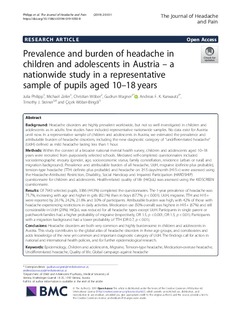| dc.contributor.author | Philipp, Julia | |
| dc.contributor.author | Zeiler, Michael | |
| dc.contributor.author | Wöber, Christian | |
| dc.contributor.author | Wagner, Gudrun | |
| dc.contributor.author | Karwautz, Andreas | |
| dc.contributor.author | Steiner, Timothy J. | |
| dc.contributor.author | Wober-Bingol, Cicek | |
| dc.date.accessioned | 2020-02-27T09:13:33Z | |
| dc.date.available | 2020-02-27T09:13:33Z | |
| dc.date.created | 2020-01-01T13:27:40Z | |
| dc.date.issued | 2019 | |
| dc.identifier.citation | The Journal of Headache and Pain. 2019, 20 (1) | nb_NO |
| dc.identifier.issn | 1129-2369 | |
| dc.identifier.uri | http://hdl.handle.net/11250/2644102 | |
| dc.description.abstract | Background: Headache disorders are highly prevalent worldwide, but not so well investigated in children and adolescents as in adults: few studies have included representative nationwide samples. No data exist for Austria until now. In a representative sample of children and adolescents in Austria, we estimated the prevalence and attributable burden of headache disorders, including the new diagnostic category of “undifferentiated headache” (UdH) defined as mild headache lasting less than 1 hour. Methods: Within the context of a broader national mental health survey, children and adolescents aged 10–18 years were recruited from purposively selected schools. Mediated self-completed questionnaires included sociodemographic enquiry (gender, age, socioeconomic status, family constellation, residence [urban or rural] and migration background). Prevalence and attributable burden of all headache, UdH, migraine (definite plus probable), tension-type headache (TTH: definite plus probable) and headache on ≥15 days/month (H15+) were assessed using the Headache-Attributed Restriction, Disability, Social Handicap and Impaired Participation (HARDSHIP) questionnaire for children and adolescents. Health-related quality of life (HrQoL) was assessed using the KIDSCREEN questionnaire. Results: Of 7643 selected pupils, 3386 (44.3%) completed the questionnaires. The 1-year prevalence of headache was 75.7%, increasing with age and higher in girls (82.1%) than in boys (67.7%; p < 0.001). UdH, migraine, TTH and H15+ were reported by 26.1%, 24.2%, 21.6% and 3.0% of participants. Attributable burden was high, with 42% of those with headache experiencing restrictions in daily activities. Medication use (50% overall) was highest in H15+ (67%) and still considerable in UdH (29%). HrQoL was reduced for all headache types except UdH. Participants in single parent or patchwork families had a higher probability of migraine (respectively, OR 1.5, p < 0.001; OR 1.5, p < 0.01). Participants with a migration background had a lower probability of TTH (OR 0.7, p < 0.01). Conclusions: Headache disorders are both very common and highly burdensome in children and adolescents in Austria. This study contributes to the global atlas of headache disorders in these age groups, and corroborates and adds knowledge of the new yet common and important diagnostic category of UdH. The findings call for action in national and international health policies, and for further epidemiological research. | nb_NO |
| dc.language.iso | eng | nb_NO |
| dc.publisher | BioMed Central | nb_NO |
| dc.rights | Navngivelse 4.0 Internasjonal | * |
| dc.rights.uri | http://creativecommons.org/licenses/by/4.0/deed.no | * |
| dc.title | Prevalence and burden of headache in children and adolescents in Austria - A nationwide study in a representative sample of pupils aged 10-18 years | nb_NO |
| dc.type | Journal article | nb_NO |
| dc.type | Peer reviewed | nb_NO |
| dc.description.version | publishedVersion | nb_NO |
| dc.source.volume | 20 | nb_NO |
| dc.source.journal | The Journal of Headache and Pain | nb_NO |
| dc.source.issue | 1 | nb_NO |
| dc.identifier.doi | 10.1186/s10194-019-1050-8 | |
| dc.identifier.cristin | 1764680 | |
| dc.description.localcode | Open Access This article is distributed under the terms of the Creative Commons Attribution 4.0 International License (http://creativecommons.org/licenses/by/4.0/), which permits unrestricted use, distribution, and reproduction in any medium, provided you give appropriate credit to the original author(s) and the source, provide a link to the Creative Commons license, and indicate if changes were made. | nb_NO |
| cristin.unitcode | 194,65,30,0 | |
| cristin.unitname | Institutt for nevromedisin og bevegelsesvitenskap | |
| cristin.ispublished | true | |
| cristin.fulltext | original | |
| cristin.qualitycode | 1 | |

